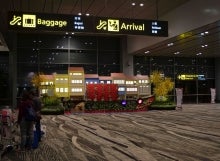Music in Airports

Airports fall into what Marc Augé has defined as a "non-place." Augé's term refers to anthropological spaces of transience that do not hold enough significance to be regarded as "places". Other "non-places" include highways, hotel rooms, supermarkets, train stations, and bus terminals. Despite an airport falling into the catagory of "non-place," garnering the space little significance, many airports pipe recorded music throughout their terminals. What does this music say about the space it occupies? What aspect or aspects of culture are being transmitted through these musics? As I begin a possible long term study of music in airports, I ask how ethnomusicology should address these musics. What music can be found in these spaces? How does it help one understand the culture of that particular space?
Famously, Brain Eno sought to address this issue with his 1978 release Music for Airports. The album is constructed of four layered tape loops of differing lengths. The four compositions captured musicians performing and perparing to perform acoustic piano and vocal music with room microphones allowing for a heavy amount of room ambience. Electronics and synthesizers were added in the postproduction phase. It was the first of four albums released in Eno's "Ambient" series, a term he used to differentiate his experimental and minimalistic approach to composition. It was one of the first recordings to be explicitlly labeled "ambient music."
Music for Airports was meant to be continuously looped as a sound installation. Eno thought his recording could diffuse some of the tense atmosphere he felt in airport terminals while being as ignorable as it is interesting. Instead of instilling the sense of false glee typical of most background musics, Eno's Music for Airports was intended to calm a listener's mind and reduce the general anxiety of the airport terminal setting. Music for Airports was installed at the Marine Air Terminal of New York's LaGuardia Airport for a brief period during the 1980s.
Following Eno's general fascination with the music in airports, I sought to document the music I heard in airports as I traveled from Los Angeles, California to Denpasar, Bali in the summer of 2015. My itinerary took me through airport terminals in Los Angeles (LAX), Tokyo (NRT), and Singapore (SIN). I focused my audio recording device directly at the speakers to compete with the other ambiences of the terminals and took a photo of a nearby scene from where the audio recording was taken.
References
Auge, Marc. 1995. "Non-places: Introduction to an Anthropology of Supermodernity." London: Verso Press.
Weisbard, Eric and Craig Marks, 1995. Spin Alternative Record Guide. New York: Vintage Books.





